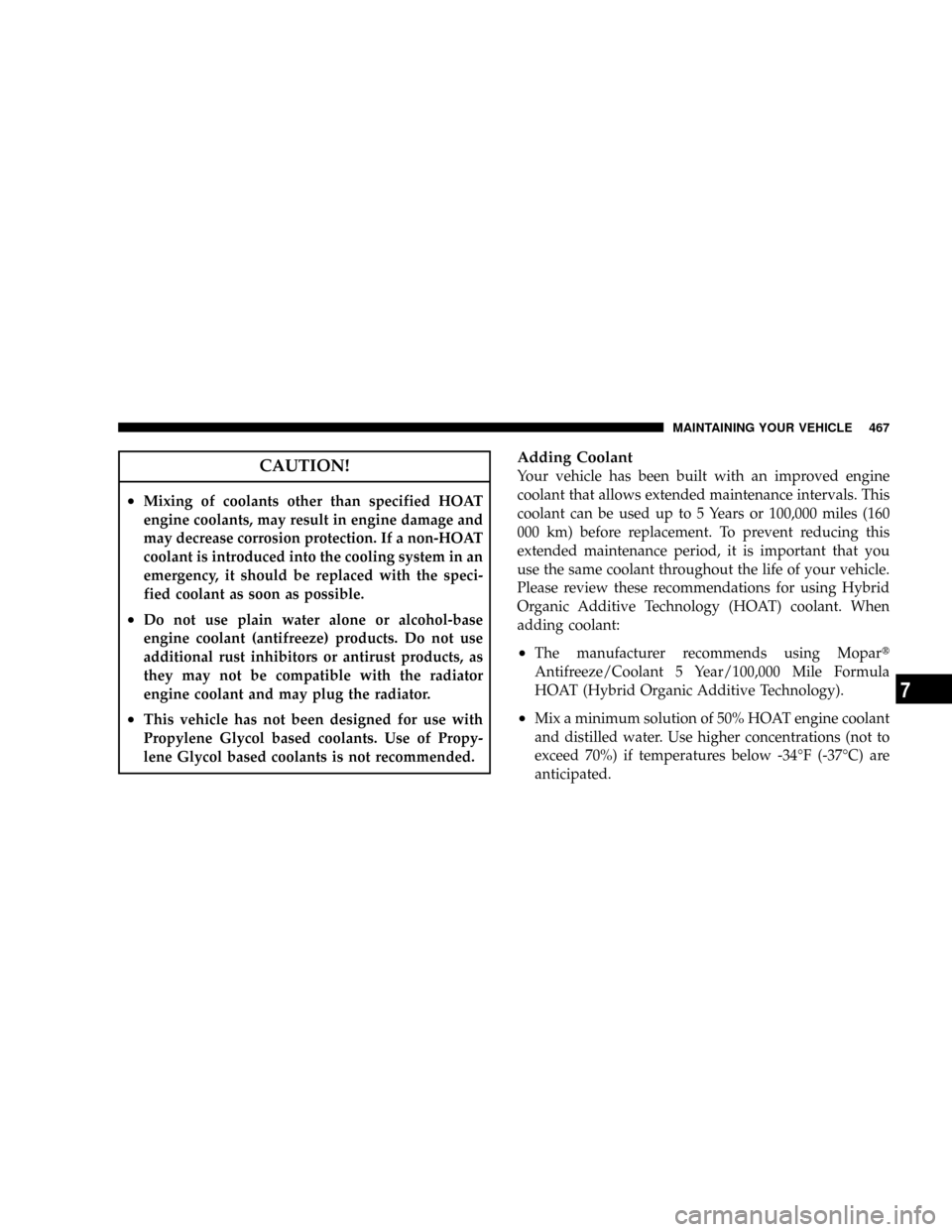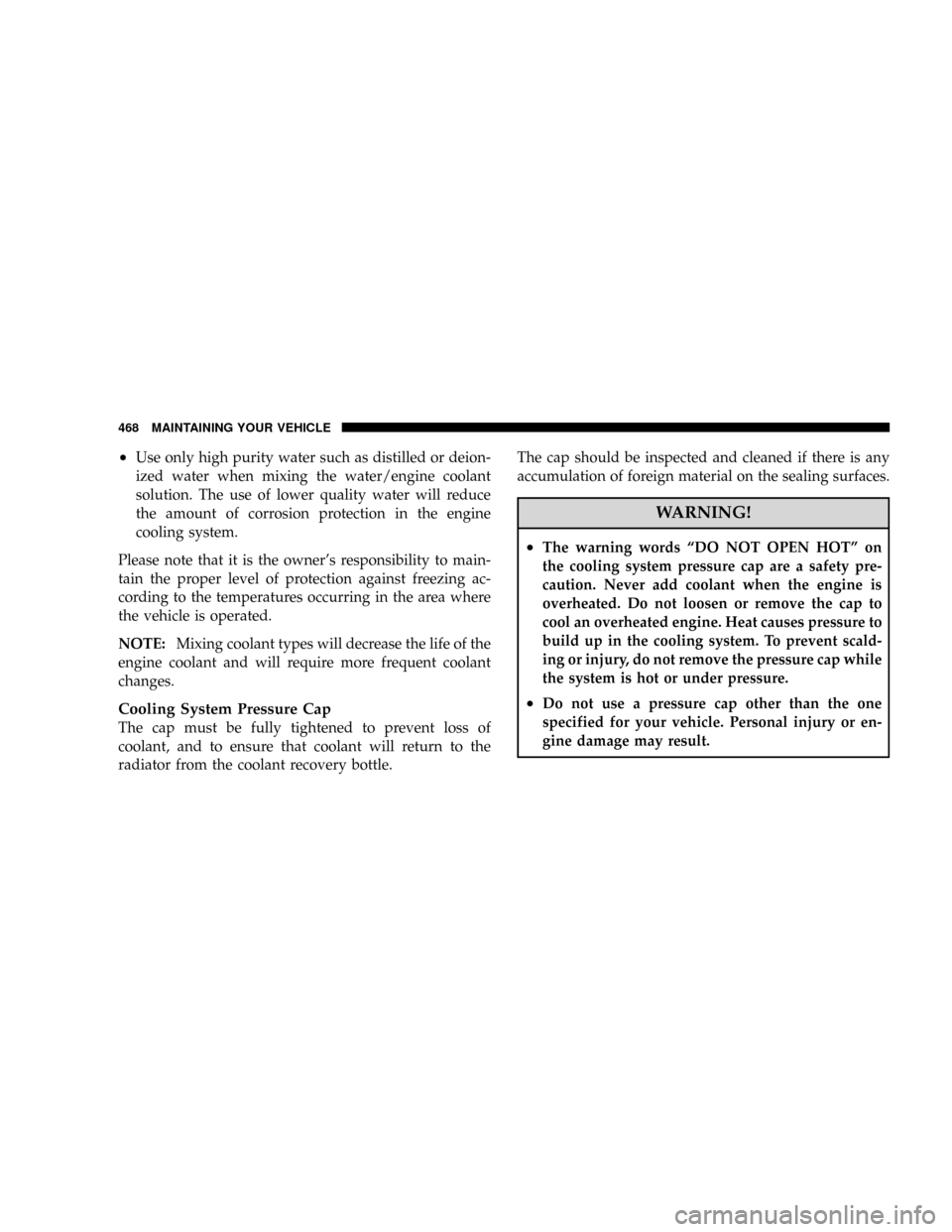2008 DODGE RAM 3500 GAS coolant temperature
[x] Cancel search: coolant temperaturePage 469 of 554

CAUTION!
²Mixing of coolants other than specified HOAT
engine coolants, may result in engine damage and
may decrease corrosion protection. If a non-HOAT
coolant is introduced into the cooling system in an
emergency, it should be replaced with the speci-
fied coolant as soon as possible.
²Do not use plain water alone or alcohol-base
engine coolant (antifreeze) products. Do not use
additional rust inhibitors or antirust products, as
they may not be compatible with the radiator
engine coolant and may plug the radiator.
²This vehicle has not been designed for use with
Propylene Glycol based coolants. Use of Propy-
lene Glycol based coolants is not recommended.
Adding Coolant
Your vehicle has been built with an improved engine
coolant that allows extended maintenance intervals. This
coolant can be used up to 5 Years or 100,000 miles (160
000 km) before replacement. To prevent reducing this
extended maintenance period, it is important that you
use the same coolant throughout the life of your vehicle.
Please review these recommendations for using Hybrid
Organic Additive Technology (HOAT) coolant. When
adding coolant:
²The manufacturer recommends using Mopart
Antifreeze/Coolant 5 Year/100,000 Mile Formula
HOAT (Hybrid Organic Additive Technology).
²Mix a minimum solution of 50% HOAT engine coolant
and distilled water. Use higher concentrations (not to
exceed 70%) if temperatures below -34ÉF (-37ÉC) are
anticipated.
MAINTAINING YOUR VEHICLE 467
7
Page 470 of 554

²Use only high purity water such as distilled or deion-
ized water when mixing the water/engine coolant
solution. The use of lower quality water will reduce
the amount of corrosion protection in the engine
cooling system.
Please note that it is the owner's responsibility to main-
tain the proper level of protection against freezing ac-
cording to the temperatures occurring in the area where
the vehicle is operated.
NOTE:Mixing coolant types will decrease the life of the
engine coolant and will require more frequent coolant
changes.
Cooling System Pressure Cap
The cap must be fully tightened to prevent loss of
coolant, and to ensure that coolant will return to the
radiator from the coolant recovery bottle.The cap should be inspected and cleaned if there is any
accumulation of foreign material on the sealing surfaces.
WARNING!
²The warning words ªDO NOT OPEN HOTº on
the cooling system pressure cap are a safety pre-
caution. Never add coolant when the engine is
overheated. Do not loosen or remove the cap to
cool an overheated engine. Heat causes pressure to
build up in the cooling system. To prevent scald-
ing or injury, do not remove the pressure cap while
the system is hot or under pressure.
²Do not use a pressure cap other than the one
specified for your vehicle. Personal injury or en-
gine damage may result.
468 MAINTAINING YOUR VEHICLE
Page 471 of 554

Disposal of Used Engine Coolant
Used ethylene glycol-based engine coolant is a regulated
substance requiring proper disposal. Check with your
local authorities to determine the disposal rules for your
community. To prevent ingestion by animals or children
do not store ethylene glycol-based engine coolant in open
containers or allow it to remain in puddles on the
ground. If ingested by a child, contact a physician
immediately. Clean up any ground spills immediately.
Coolant Level
The coolant bottle provides a quick visual method for
determining that the coolant level is adequate. With the
engine cold, the level of the coolant in the coolant
recovery bottle should be between the ranges indicated
on the bottle.
The radiator normally remains completely full, so there is
no need to remove the radiator cap unless checking for
coolant freeze point or replacing coolant. Advise yourservice attendant of this. As long as the engine operating
temperature is satisfactory, the coolant bottle need only
be checked once a month.
When additional coolant is needed to maintain the
proper level, it should be added to the coolant bottle. Do
not overfill.
Points To Remember
NOTE:When the vehicle is stopped after a few miles (a
few kilometers) of operation, you may observe vapor
coming from the front of the engine compartment. This is
normally a result of moisture from rain, snow, or high
humidity accumulating on the radiator and being vapor-
ized when the thermostat opens, allowing hot coolant to
enter the radiator.
If an examination of your engine compartment shows no
evidence of radiator or hose leaks, the vehicle may be
safely driven. The vapor will soon dissipate.
MAINTAINING YOUR VEHICLE 469
7
Page 537 of 554

Pressure Cap......................... 468
Radiator Cap......................... 468
Selection of Coolant (Antifreeze)......466,508,510
Temperature Gauge..................... 198
Cruise Control (Speed Control).............. 145
Cupholders............................ 169
Customer Assistance..................... 523
Data Recorder, Event...................... 60
Daytime Running Lights................... 137
Dealer Service.......................... 450
Defroster, Rear Window.................89,182
Defroster, Windshield................79,260,263
Delay (Intermittent) Wipers................. 141
Differential, Limited-Slip.................. 313
Dipsticks
Automatic Transmission................. 477
Power Steering........................ 460
Disc Brakes............................ 471Disposal
Antifreeze (Engine Coolant)............... 469
Door Locks............................. 27
Door Opener, Garage..................... 156
Drive Belts............................ 454
Drive Shaft Universal Joints................ 461
Driving
Through Flowing, Rising, or Shallow Standing
Water................................ 315
Dual Rear Wheels.....................361,431
DVD Player (Video Entertainment SystemŸ).... 251
E-85 Fuel............................. 377
Electric Rear Window Defrost.............89,182
Electrical Power Outlets................... 166
Electronic Brake Control System............. 324
Anti-Lock Brake System................. 325
Brake Assist System.................... 326
Electronic Roll Mitigation................ 332
INDEX 535
10
Page 538 of 554

Electronic Stability Program............... 333
Traction Control System................. 326
Electronic Roll Mitigation (ERM)............. 332
Electronic Speed Control (Cruise Control)...... 145
Electronic Stability Program (ESP).........204,333
Electronically Shifted Transfer Case........298,306
Emergency Brake........................ 318
Emergency, In Case of
Freeing Vehicle When Stuck............... 437
Hazard Warning Flasher................. 416
Jacking............................. 423
Jump Starting......................... 434
Tow Hooks.......................... 438
Towing............................. 439
Emission Control System Maintenance......... 514
Emission Related Components.............. 457
Engine..........................444,445,446
Air Cleaner.......................... 455
Block Heater......................... 282Break-In Recommendations................ 76
Compartment Identification.........444,445,446
Coolant (Antifreeze).................... 510
Exhaust Gas Caution.................... 375
Flooded, Starting...................... 280
Fuel Requirements..................... 508
Multi-Displacement..................... 338
Oil ...........................451,508,510
Oil Filler Cap......................... 452
Oil Selection.......................452,508
Oil Synthetic......................... 453
Temperature Gauge..................... 198
Equipment Identification Plate.............. 413
Event Data Recorder...................... 60
Exhaust Gas Caution..............78,187,375,465
Exhaust System....................78,464,465
Exterior Lighting........................ 136
Fabric Care............................ 486
536 INDEX
Page 540 of 554

Tank Capacity........................ 508
Fuel, Flexible.............See Flexible Fuel Vehicles
Fuses................................ 489
Garage Door Opener (HomeLinkt) ........... 156
Gas Cap (Fuel Filler Cap)...............377,447
Gasoline (Fuel)......................... 371
Gasoline, Reformulated................... 372
Gauges............................... 196
Coolant Temperature.................... 198
Fuel................................ 207
Oil Pressure.......................... 197
Speedometer......................... 197
Tachometer.......................... 196
Voltmeter............................ 196
Gear Ranges........................283,290
General Information.................18,117,371
Glass Cleaning.......................... 488
Grocery Bag Retainer..................... 178Gross Axle Weight Rating.................. 386
Gross Vehicle Weight Rating................ 385
Guide, Body Builders...................... 6
GVWR............................... 381
Hands-Free Phone (UConnectt) .............. 91
Hazard
Driving Through Flowing, Rising, or Shallow
Standing Water......................... 315
Hazard Warning Flasher................... 416
Head Restraints......................... 121
Headlights............................ 495
Cleaning............................ 487
High Beam........................... 140
High Beam/Low Beam Select Switch........ 140
Lights On Reminder.................... 138
Passing............................. 140
Switch.............................. 136
Heated Mirrors.......................89,182
538 INDEX